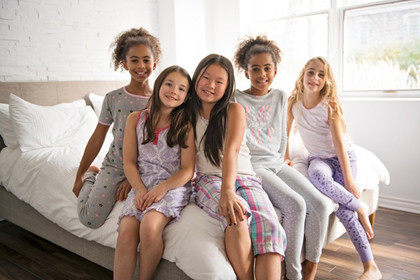Children's sleepwear safety
Learn to dress your child safely for sleep time.
On this page
Types of sleepwear
Loose-fitting sleepwear includes:
- nightgowns
- loose pyjamas
- baby doll pyjamas
- these are a loose-fitting short and top set
Tight-fitting sleepwear includes:
- sleepers
- polo pyjamas
- these are a 2-piece clothing set
- the long-sleeved top and pants have cuffs to keep the pants and top in place
Bathrobes are also considered sleepwear because children often wear them after baths while getting ready for bed. Remember to remove them before your child goes to sleep to avoid strangulation on bathrobe belts, ties or sashes.
If your child wears a bathrobe when they're awake, make sure any belts, ties or sashes on children's bathrobes are stitched firmly to the centre back of these products.
Fabrics and flammability
For sleep time, your child is safest when dressed in sleepwear. That's because the flammability requirements for children's daywear are different than those for sleepwear.
Children's sleepwear sold in Canada must meet strict flammability requirements. These requirements help to protect children from burns if their sleepwear comes in contact with ignition sources, like stove elements, candles and matches.
Loose-fitting sleepwear (styles with flowing skirts, wide sleeves or wide ruffles) may be more likely to catch on fire than tight-fitting sleepwear (styles like polo pyjamas).
If you prefer 100% cotton fabrics, tight-fitting sleepwear is the safer option.
If your child wears loose-fitting sleepwear, make sure it's made of slower-burning fabrics. Cotton, cotton-blend and rayon fabrics tend to catch fire and burn more quickly than most synthetic materials. Nylon and polyester do not catch fire as easily as cotton does and they tend to burn more slowly.
Teach your children about the dangers of fire. Tell them to "stop, drop and roll" if their clothes catch fire.
Sleepwear safety tips
Follow these safety tips to help keep your children safe while they are sleeping:
- dress them in actual sleepwear when putting them to bed
- some daywear may not meet the flammability requirements for sleepwear
- dress them in size-appropriate sleepwear
- sleepwear that's too big can come into contact with an ignition source more easily and may burn more quickly
- check sleepwear regularly for:
- loose buttons, snaps, zipper pulls or other small parts, which could become a choking hazard
- loose threads and fix them immediately, as the threads can become wrapped around your child's arms, legs, fingers, toes or neck and cause injury
